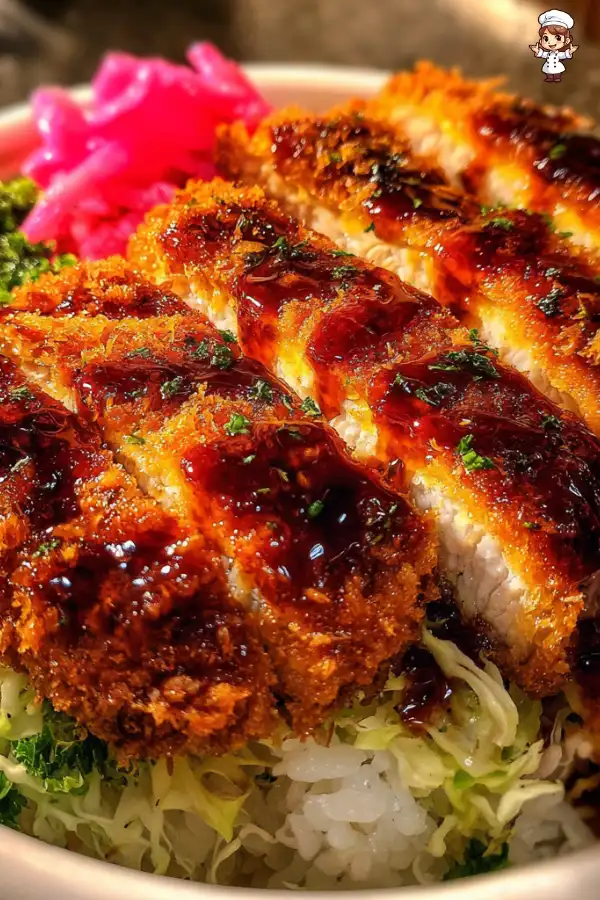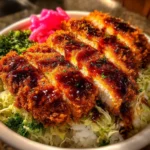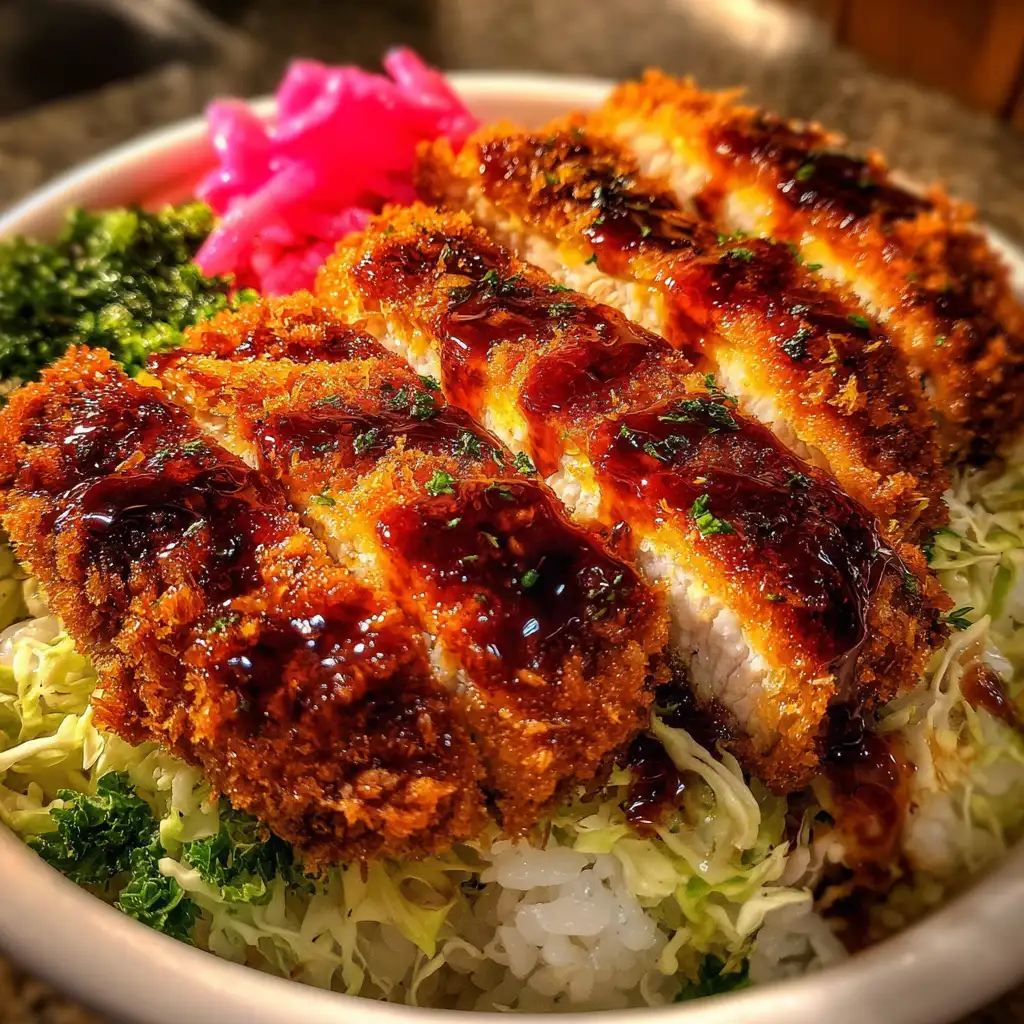Japanese Katsu Bowls are a delightful dish that combines crispy fried meat with fluffy rice and fresh vegetables. The star of this dish is the katsu, which is typically made from pork or chicken. The meat is breaded and fried until golden brown, creating a crunchy texture that contrasts beautifully with the soft rice. Served in a bowl, it often includes shredded cabbage and a drizzle of savory tonkatsu sauce. This dish is not only delicious but also visually appealing, making it a favorite in Japanese cuisine.
The Importance of Tonkatsu Sauce in Japanese Katsu Bowls
Tonkatsu sauce is a key ingredient that elevates Japanese Katsu Bowls to a whole new level. This thick, sweet, and tangy sauce is made from a blend of fruits, vegetables, and spices. It adds a rich flavor that complements the crispy katsu perfectly. Without tonkatsu sauce, the dish would lack that essential zing that makes each bite so enjoyable. It’s often compared to a barbecue sauce but with a unique twist that reflects Japanese culinary traditions. Drizzling this sauce over the katsu not only enhances the taste but also adds a beautiful glossy finish to the dish.
Ingredients for Japanese Katsu Bowls with Tonkatsu Sauce
To create a delicious Japanese Katsu Bowl with Tonkatsu Sauce, you will need a few key ingredients. Each component plays a vital role in achieving the perfect balance of flavors and textures. Here’s what you’ll need:
- 2 boneless pork chops (about 1 lb or 450 g) – This is the main protein in your dish. Choose fresh, high-quality pork for the best results.
- Salt and pepper – to taste. These simple seasonings enhance the natural flavor of the pork.
- 1/2 cup all-purpose flour – This is used for dredging the pork, helping the egg and breadcrumbs stick.
- 2 large eggs – Beaten eggs create a binding layer for the breadcrumbs.
- 1 cup panko breadcrumbs – These Japanese-style breadcrumbs give the katsu its signature crunch.
- Vegetable oil – for frying. Choose a neutral oil with a high smoke point, like canola or sunflower oil.
- 2 cups cooked Japanese short-grain rice – This rice is sticky and fluffy, making it the perfect base for your katsu.
- 2 cups shredded cabbage – Fresh cabbage adds a nice crunch and balances the richness of the pork.
- 1/4 cup tonkatsu sauce – This sweet and tangy sauce is essential for flavoring your katsu.
- 1/4 cup pickled ginger – For serving, this adds a refreshing contrast to the dish.
Gathering these ingredients will set you on the right path to making a delightful Japanese Katsu Bowl with Tonkatsu Sauce. Each element contributes to the overall experience, making it a dish that is both satisfying and enjoyable.
Step-by-Step Preparation of Japanese Katsu Bowls with Tonkatsu Sauce

Step 1: Preparing the Ingredients
Before you start cooking, it’s important to prepare all your ingredients. First, take the boneless pork chops and place them between two sheets of plastic wrap. Using a meat mallet or a rolling pin, gently pound the pork until it’s about 1/2 inch thick. This helps tenderize the meat and ensures even cooking. Next, season both sides of the pork with salt and pepper. This simple step enhances the flavor of the katsu.
While you’re at it, gather your other ingredients. Set up a breading station with three shallow dishes. In the first dish, add the all-purpose flour. In the second dish, beat the two large eggs. Finally, place the panko breadcrumbs in the third dish. Having everything ready will make the cooking process smoother and more enjoyable.
Step 2: Making the Tonkatsu Sauce
While the pork is being prepared, you can make your tonkatsu sauce. If you have store-bought tonkatsu sauce, you can skip this step. However, making it at home is simple and rewarding. Combine 1/4 cup of ketchup, 1 tablespoon of Worcestershire sauce, 1 tablespoon of soy sauce, and 1 teaspoon of sugar in a small bowl. Mix well until the sugar dissolves. This homemade version will add a personal touch to your dish.
Step 3: Cooking the Katsu
Now it’s time to cook the katsu! In a large skillet, heat about 1/2 inch of vegetable oil over medium heat. To check if the oil is hot enough, drop a few breadcrumbs into the oil. If they sizzle, you’re ready to go! Carefully add the breaded pork chops to the skillet. Fry them for about 4-5 minutes on each side, or until they turn golden brown and are cooked through. Use a meat thermometer to ensure the internal temperature reaches 145°F (63°C). Once cooked, transfer the pork to a paper towel-lined plate to drain any excess oil.
Step 4: Assembling the Japanese Katsu Bowls
With the katsu cooked, it’s time to assemble your Japanese Katsu Bowls! Start by creating a fluffy bed of cooked Japanese short-grain rice in each serving bowl. Slice the fried pork cutlets into strips and arrange them on top of the rice. Next, add a generous portion of shredded cabbage beside the pork. This adds a refreshing crunch that balances the richness of the katsu.
Finally, drizzle the homemade or store-bought tonkatsu sauce over the pork cutlets, allowing it to pool slightly on the rice. For an extra burst of flavor, serve with a side of pickled ginger. Your Japanese Katsu Bowl is now ready to be enjoyed!
Tips for Perfecting Japanese Katsu Bowls with Tonkatsu Sauce
Choosing the Right Cut of Meat
When making Japanese Katsu Bowls with Tonkatsu Sauce, selecting the right cut of meat is crucial. The most common choice is pork loin or pork tenderloin. These cuts are tender and flavorful, making them perfect for frying. If you prefer chicken, boneless chicken thighs or breasts work well too. They provide a juicy texture that pairs nicely with the crispy coating. Always look for fresh meat with a nice pink color. Avoid any cuts that appear discolored or have an off smell. This ensures your katsu will be delicious and safe to eat.
Achieving the Perfect Crunch
To achieve that signature crunch in your katsu, follow a few simple tips. First, make sure to use panko breadcrumbs. These Japanese-style breadcrumbs are lighter and crispier than regular breadcrumbs, giving your katsu a delightful texture. When breading the pork, press the panko firmly onto the meat to ensure it sticks well. Additionally, frying in hot oil is essential. If the oil is not hot enough, the katsu will absorb too much oil and become soggy. A good rule of thumb is to maintain the oil temperature around 350°F (175°C). Lastly, avoid overcrowding the pan. Frying in batches allows the katsu to cook evenly and stay crispy. With these tips, your Japanese Katsu Bowls will be a hit!
Variations of Japanese Katsu Bowls with Tonkatsu Sauce
Vegetarian Options for Japanese Katsu Bowls
If you’re looking for a vegetarian twist on the classic Japanese Katsu Bowl with Tonkatsu Sauce, you’re in luck! There are several delicious alternatives that can satisfy your cravings. One popular option is to use eggplant or zucchini. Simply slice these vegetables into thick pieces, then follow the same breading and frying process as you would with pork. The result is a crispy, flavorful katsu that pairs beautifully with the tonkatsu sauce.
Another great choice is to use tofu. Firm tofu works best for this dish. Start by pressing the tofu to remove excess moisture, then slice it into thick slabs. Bread and fry the tofu just like you would with meat. The crispy exterior and soft interior create a delightful contrast. Serve your vegetarian katsu over rice, topped with shredded cabbage and drizzled with tonkatsu sauce for a satisfying meal.
Different Sauces to Pair with Katsu
While tonkatsu sauce is the traditional choice for Japanese Katsu Bowls, there are many other sauces you can try for a unique flavor experience. For instance, you might enjoy a sweet chili sauce. This sauce adds a spicy kick that complements the crispy katsu perfectly. Simply drizzle it over the pork or tofu before serving.
Another option is to use a sesame dressing. This creamy sauce, made from sesame paste, soy sauce, and vinegar, adds a nutty flavor that pairs well with the dish. You can also experiment with a homemade teriyaki sauce for a sweeter taste. Just mix soy sauce, mirin, and sugar, then simmer until thickened. Drizzle this over your katsu for a delightful twist.
Feel free to get creative with your sauces! Each variation can bring a new dimension to your Japanese Katsu Bowls with Tonkatsu Sauce, making every meal a new adventure.
FAQs about Japanese Katsu Bowls with Tonkatsu Sauce
What is the origin of Katsu?
Katsu, short for “katsuretsu,” has its roots in Japan. It was inspired by Western-style breaded and fried cutlets, particularly the European schnitzel. The dish became popular in Japan during the Meiji era, around the late 19th century. Over time, katsu evolved into a beloved comfort food, often served with rice and shredded cabbage. Today, it is a staple in Japanese cuisine, enjoyed by many around the world.
Can I make Tonkatsu Sauce at home?
Absolutely! Making tonkatsu sauce at home is simple and requires just a few ingredients. You can combine ketchup, Worcestershire sauce, soy sauce, and a bit of sugar to create a delicious homemade version. Mix these ingredients in a bowl until well combined. This sauce adds a unique flavor to your katsu and can be adjusted to suit your taste. Feel free to experiment with the ratios to find your perfect blend!
What can I serve with Japanese Katsu Bowls?
Japanese Katsu Bowls are delicious on their own, but you can enhance your meal with a few side dishes. Miso soup is a classic pairing that complements the flavors of the katsu. A simple salad with a sesame dressing can also add freshness to your meal. Additionally, pickled vegetables, like pickled ginger or daikon, provide a nice contrast to the richness of the katsu. These sides create a well-rounded dining experience that is both satisfying and enjoyable.
How do I store leftovers of Japanese Katsu Bowls with Tonkatsu Sauce?
If you have leftovers, storing them properly is key to maintaining their flavor and texture. First, let the katsu cool to room temperature. Then, place the pork cutlets in an airtight container. You can store the cooked rice and shredded cabbage separately to keep everything fresh. Refrigerate the leftovers for up to three days. When you’re ready to enjoy them again, reheat the katsu in an oven or air fryer to restore its crispiness. Avoid microwaving, as this can make the katsu soggy. Enjoy your delicious leftovers!
Print
Japanese Katsu Bowls with Tonkatsu Sauce are irresistible!
- Total Time: 40 minutes
- Yield: 2 servings 1x
- Diet: Gluten Free
Description
Japanese Katsu Bowls are a delightful dish that combines crispy fried meat with fluffy rice and fresh vegetables, topped with savory tonkatsu sauce.
Ingredients
- 2 boneless pork chops (about 1 lb or 450 g)
- Salt and pepper – to taste
- 1/2 cup all-purpose flour
- 2 large eggs – beaten
- 1 cup panko breadcrumbs
- Vegetable oil – for frying
- 2 cups cooked Japanese short-grain rice
- 2 cups shredded cabbage
- 1/4 cup tonkatsu sauce
- 1/4 cup pickled ginger
Instructions
- Prepare the pork chops by pounding them to 1/2 inch thick and seasoning with salt and pepper.
- Set up a breading station with flour, beaten eggs, and panko breadcrumbs.
- Make the tonkatsu sauce by mixing ketchup, Worcestershire sauce, soy sauce, and sugar in a bowl.
- Heat vegetable oil in a skillet and fry the breaded pork chops until golden brown and cooked through.
- Assemble the bowls with rice, sliced pork, shredded cabbage, and drizzle with tonkatsu sauce.
- Serve with pickled ginger on the side.
Latest Amazon Finds
Notes
- Use fresh, high-quality pork for the best results.
- Ensure the oil is hot enough before frying to achieve a crispy texture.
- Press the panko breadcrumbs firmly onto the meat for better adhesion.
- Fry in batches to avoid overcrowding the pan.
- Prep Time: 20 minutes
- Cook Time: 20 minutes
- Category: Main Course
- Method: Frying
- Cuisine: Japanese
Nutrition
- Serving Size: 1 bowl
- Calories: 700
- Sugar: 5g
- Sodium: 800mg
- Fat: 30g
- Saturated Fat: 5g
- Unsaturated Fat: 20g
- Trans Fat: 0g
- Carbohydrates: 80g
- Fiber: 3g
- Protein: 30g
- Cholesterol: 150mg
Keywords: Japanese Katsu, Tonkatsu Sauce, Fried Pork, Rice Bowl, Japanese Cuisine








